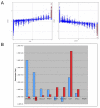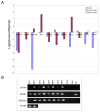Gene expression down-regulation in CD90+ prostate tumor-associated stromal cells involves potential organ-specific genes
- PMID: 19737398
- PMCID: PMC2745432
- DOI: 10.1186/1471-2407-9-317
Gene expression down-regulation in CD90+ prostate tumor-associated stromal cells involves potential organ-specific genes
Abstract
Background: The prostate stroma is a key mediator of epithelial differentiation and development, and potentially plays a role in the initiation and progression of prostate cancer. The tumor-associated stroma is marked by increased expression of CD90/THY1. Isolation and characterization of these stromal cells could provide valuable insight into the biology of the tumor microenvironment.
Methods: Prostate CD90+ stromal fibromuscular cells from tumor specimens were isolated by cell-sorting and analyzed by DNA microarray. Dataset analysis was used to compare gene expression between histologically normal and tumor-associated stromal cells. For comparison, stromal cells were also isolated and analyzed from the urinary bladder.
Results: The tumor-associated stromal cells were found to have decreased expression of genes involved in smooth muscle differentiation, and those detected in prostate but not bladder. Other differential expression between the stromal cell types included that of the CXC-chemokine genes.
Conclusion: CD90+ prostate tumor-associated stromal cells differed from their normal counterpart in expression of multiple genes, some of which are potentially involved in organ development.
Figures





References
-
- Cunha GR, Donjacour AA. Mesenchymal-epithelial interactions in the growth and development of the prostate. Cancer Treat Res. 1989;46:159–175. - PubMed
-
- Burger PE, Xiong X, Coetzee S, Salm SN, Moscatelli D, Goto K, Wilson EL. Sca-1 expression identifies stem cells in the proximal region of prostatic ducts with high capacity to reconstitute prostatic tissue. Proc Natl Acad Sci USA. 2005;102(20):7180–7185. doi: 10.1073/pnas.0502761102. - DOI - PMC - PubMed
Publication types
MeSH terms
Substances
Associated data
- Actions
Grants and funding
LinkOut - more resources
Full Text Sources
Medical
Molecular Biology Databases
Miscellaneous

